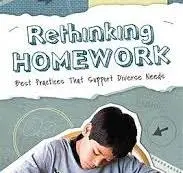In the ever-evolving landscape of education, the traditional concept of homework is undergoing a significant transformation. Rethinking Homework: As educators and researchers delve deeper into the effectiveness of various teaching methods, the focus is shifting from rigid assignments to more flexible, personalized approaches. This blog explores how flexible homework assignments are changing the way students learn, engage, and succeed.
The Traditional Homework Model: A One-Size-Fits-All Approach
For decades, homework has been a staple of the educational experience, often viewed as a necessary tool for reinforcing classroom learning. However, the traditional model typically involves standardized assignments that may not cater to the diverse needs and learning styles of students. This one-size-fits-all approach can lead to frustration, disengagement, and even burnout among students.
The Case for Flexibility in Assignments
As educators seek to create more inclusive and effective learning environments, the concept of flexible assignments is gaining traction. Flexible homework allows students to choose how they demonstrate their understanding of a topic, fostering a sense of ownership and agency in their learning process. Here are some key benefits of this approach:
1. Personalization of Learning
Flexible assignments enable students to tailor their work to their interests and strengths. For instance, a student might choose to create a video presentation, write a report, or design a poster to showcase their understanding of a subject. This personalization not only enhances engagement but also allows students to explore topics in ways that resonate with them.
2. Encouraging Critical Thinking and Creativity
When students are given the freedom to approach assignments in various ways, they are encouraged to think critically and creatively. Instead of simply regurgitating information, students must analyze, synthesize, and apply their knowledge in innovative ways. This shift promotes deeper learning and helps students develop essential skills for the future.
3. Fostering Collaboration and Communication
Flexible assignments can also facilitate collaboration among students. Group projects that allow for diverse contributions encourage teamwork and communication skills. Students learn to value each other’s perspectives and work together to achieve a common goal, preparing them for real-world scenarios.
4. Reducing Stress and Anxiety
The pressure of traditional homework can lead to stress and anxiety for many students. By offering flexibility, educators can help alleviate some of this pressure. Students can choose deadlines that work for them or opt for assignments that align with their current workload, promoting a healthier balance between school and personal life.
Implementing Flexible Assignments in the Classroom
Transitioning to a flexible homework model requires thoughtful planning and consideration. Here are some strategies educators can use to implement this approach effectively:
1. Provide Clear Guidelines
While flexibility is key, it’s essential to provide students with clear expectations and guidelines. Outline the learning objectives, assessment criteria, and available options for assignments. This clarity helps students understand the purpose of their work and what is expected of them.
2. Encourage Student Choice
Empower students by allowing them to choose from a variety of assignment formats. This could include written reports, creative projects, presentations, or even digital content creation. Providing options fosters a sense of ownership and encourages students to engage with the material in meaningful ways.
3. Incorporate Reflection
Encourage students to reflect on their learning experiences and the choices they made in completing their assignments. Reflection helps students develop metacognitive skills and understand their learning processes, leading to greater self-awareness and growth.
4. Solicit Feedback
Regularly seek feedback from students about their experiences with flexible assignments. Understanding their perspectives can help educators refine their approaches and ensure that the assignments are meeting the needs of all learners.
The Future of Homework: A Shift in Mindset
As we rethink homework, it’s essential to recognize that flexibility is not just about offering choices; it’s about fostering a culture of learning that values student agency, creativity, and well-being. The shift towards flexible assignments represents a broader change in educational philosophy, moving away from compliance and rote memorization towards engagement and critical thinking.
Conclusion
through the lens of flexibility is transforming the educational landscape. By embracing personalized, creative, and collaborative assignments, educators can create a more inclusive and effective learning environment. As we continue to explore innovative approaches to education, it’s clear that flexible assignments are not just a trend—they are a vital component of a modern, student-centered approach to learning.
What are your thoughts on flexible homework assignments? Have you experienced or implemented this approach in your educational journey? Share your insights in the comments below!
